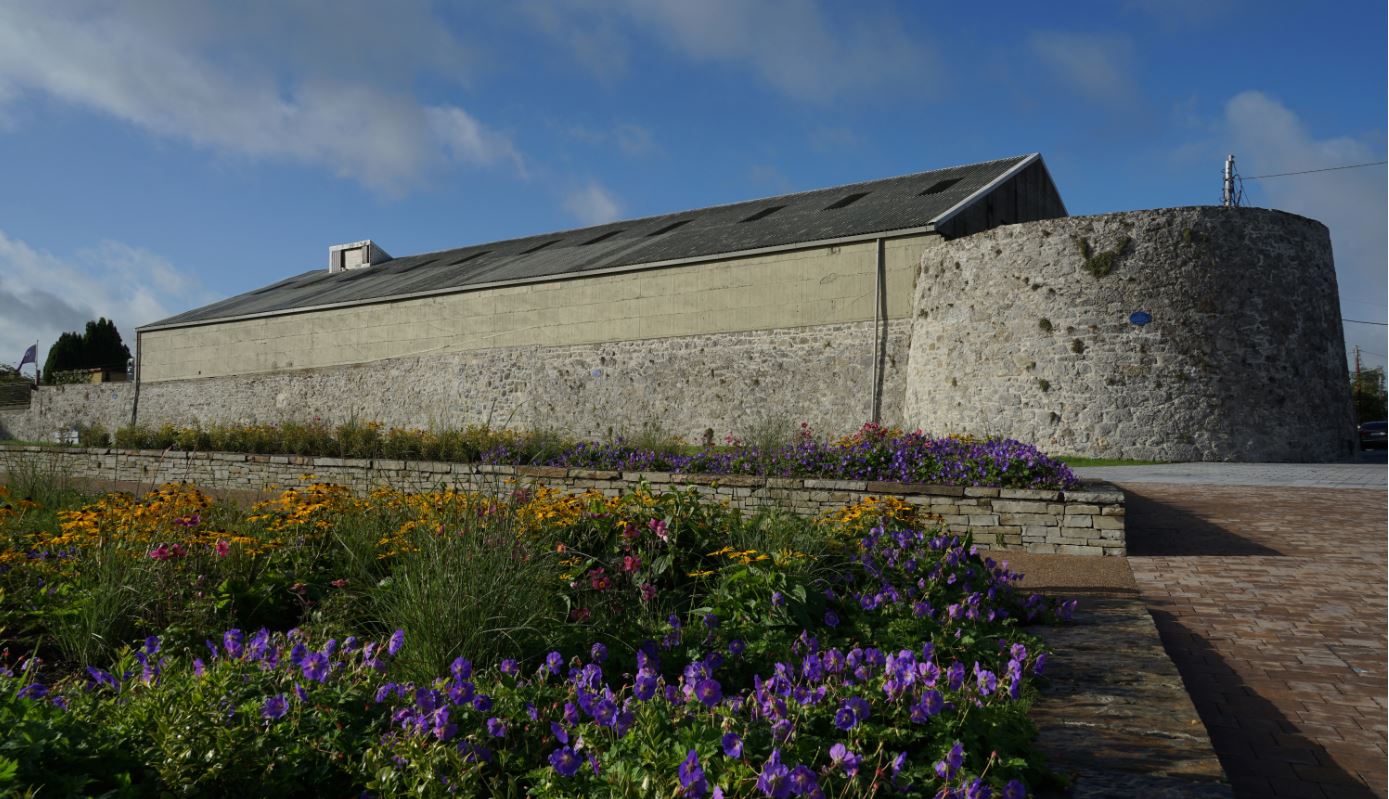1548 - the Plantation of Leinster
Laois was one of the main areas of Leinster that the English government in Ireland had lost to the Gaelic Irish during the 14th century. However, during the 15th century, the O’More and O’Connor families who ruled Laois and Offaly had found themselves under the sway of the powerful earls of Kildare. Following the rebellion of ‘Silken’ Thomas fitzGerald, and the reduction in power of the earls of Kildare, the English government now found itself in a position of negotiating directly with the O’Mores and O’Connors.
In 1541, even before Conn Bacach Ó Néill
in Ulster had accepted the terms of the English government’s policy of ‘surrender and regrant’, the Lord Deputy, Anthony St Leger had negotiated similar arrangements with Cétach Ruadh O’More of Laois in west Leinster, and Turlough O’Toole in the Wicklow mountains, on the doorstep of English administration in Dublin. Also in this year, Brian Mac Giolla Phádraig (fitzPatrick), the ruling chief of Upper Ossory (comprising the southwest of modern-day Laois), agreed terms under the ‘surrender and regrant’ scheme and was rewarded with the title baron of Upper Ossory (the title earl of Ossory was already taken by the Butler earls of Ormond). The Mac Giolla Phádraig had also been closely allied with the earls of Kildare, but now that the fitzGeralds had been removed from the Irish political stage, they found themselves in a more vulnerable position. Over the previous centuries, these families had frequently been in conflict with one another, and these disputes were frequently settled by the earls of Kildare. St Leger now proposed that the government would provide arbitration proceedings to settle any further conflicts, but ultimately he was unable to resolve the disputes that inevitably arose between the leading families. And aside from these, there were also violent disputes within families that were entirely outside his control. As in the case of Conn Bacach Ó Néill, the newly titled earl of Tyrone in Ulster, the initial period of peace offered by the ‘surrender and regrant’ scheme fell apart in Leinster, only quicker.
Following the death of Henry VIII in January 1547, Anthony St Leger was replaced as Lord Deputy by Edward Bellingham, who abandoned his predecessor’s conciliatory tactics in favour of the long-established English principle of military force. The government now constructed two new military outposts in west Leinster, Fort Governor in Offaly and Fort Protector in Laois. These were the first major fortifications built by the English government in Ireland for centuries and were quite unlike anything seen before. They comprised large square courtyards defended by stone walls with low turrets at each of the corners for gun emplacements. The large courtyards comprised parade grounds and accommodation blocks for the soldiers garrisoned there. Unlike the castles of the Anglo-Norman period that were often intended to convey the image of an impregnable fortresses and reflect the status of their lords, the Tudor forts were far more functional. Their walls and towers were comparatively low to accommodate gun emplacements and soldiers armed with muskets, and such ordnance did not need to be elevated to be effective. The open courtyards were generally much larger than was required for the garrison normally stationed at these forts, but they were very convenient for mustering large numbers of troops when necessary.
Aside from their new military architecture, they also symbolised a new departure in terms of English policy. These forts would become the military foothold to support a plantation of new English settlers into the region. This was a significant turnaround from the policy only a few years earlier of recognising the Gaelic O’Connors, O’Mores and fitzPatricks as the chief tenants of the crown in region. Embedded in the new policy was a firm belief that these Gaelic chiefs were incapable of being anglicised, and that the only means of achieving this was to bring English families to settle these lands. This was the first of several English plantations during the Tudor period and would provide the template for similar schemes elsewhere in Ireland (and beyond). Indeed, its significance can also be seen in the fact that it was the first ambitious project aimed at wholesale English colonisation in Ireland since the 13th century.
In 1550 a survey was carried-out of the lands of Laois and Offaly. By the end of the year, the first leases of lands in Laois were issued to English settlers. The initial attempts at colonisation saw mixed results. By now the Lord Deputy was Thomas Radcliffe, 3rd earl of Sussex, who arrived in Ireland in 1556. In order to put the plantation on a more secure footing, legislation was enacted in 1557, which formally confiscated Laois and Offaly from the Gaelic Irish, on the basis that it had always been claimed by the English crown, since the reign of Henry II. The lands would comprise two new shires to be called Queen’s and King’s counties (Laois and Offaly respectively), and they were to have sherrifs, coroners and all the offices required to make up a county administration. However, the systematic colonisation only truly began in early 1563. Throughout these years it was heavily dependent on the military presence provided by Fort Governor and Fort Protector.
One of those who had arrived in Laois during the early years of the plantation was Francis Cosby, whose family originally came from Nottingham in the east of England. He had arrived in Ireland in 1546 and was already here when the concept of plantation for west Leinster was evolving, so he was quick to capitalise on this new ambitious project. He first acquired lands in Laois in 1550, and by 1563 he had secured extensive lands in Stradbally. Here, Cosby built a large house for himself, reputedly using the stones from a Franciscan Friary founded in 1447 by the O’Mores. In 1564, Cosby became sheriff of Laois, and shortly later he was made constable of Fort Protector. At this time, its modest garrison consisted of ‘one porter, one drummer, one ensign [flag bearer], one surgeon and 39 arquebusiers [gunners]’.
The presence of Fort Protector quickly attracted some of the earliest settlers of the plantation project. The soldiers who initially came to garrison the fort were the first to be settled. Their presence offered a real sense of protection to the English farmers and merchants who followed. In 1556, the settlement at Fort Protector was renamed Maryborough in honour of Queen Mary. Today known as Portlaoise, this was the first town established in Ireland for nearly three centuries and was central to the growing plantation of the wider Laois countryside, and rural planters such as Cosby also kept residences in the town. A map from 1560 is one of the earliest maps that records an Irish town in detail. Maryborough was granted a market in 1567 and in 1570, Queen Elizabeth issued a charter of incorporation to the town, which provided the residents with the legal basis for establishing a formal governing body.
The plantation was not purely an English one. In several instances, Gaelic families also received lands as part of the plantation. This of course meant that they now held this land from the crown and had to pay rent and fulfill military services. However, they were now independent from their former Gaelic overlords, such as the O’Mores and O’Connors. In this way, the government further undermined the O’Mores by taking away power base. One of these was Eóghan O’Dempsey, who did very well out of the plantation.
By 1571, the leading O’More chief was Ruaidhrí Óg O’More, whose father had once resided at Stradbally. Ruaidhrí Óg was not in fact destined to become a leader among the O’More. His family was one of the junior branches of the O’More, however, the plantation had removed most of the senior members and Ruaidhrí Óg was happy to fill the vacuum. He had initially made an alliance with the leading English settler in Laois, Francis Cosby, who had acquired the Stradbally lands from his father Ruaidhrí Caoch O’More. Despite this unlikely partnership, Ruaidhrí found himself excluded from the plantation process that had benefited some of his Gaelic neighbours, such as Eóghan O’Dempsey. Eventually he resorted to violence, in order to put pressure on the government. In November 1575, Ruaidhrí Óg submitted to the Lord Deputy, Sir Henry Sidney, at St Canice’s Cathedral in Kilkenny, in anticipation of finally getting recognition of a large portion of the O’More ancestral lands. However, Sidney hesitated, and with no obvious sign of a favourable response, Ruaidhrí Óg went on the rampage, and captured Sidney’s nephew, Captain Henry Harrington and Alexander Cosby, son of Francis Cosby. In October 1577, government troops fell upon the house where Ruaidhrí Óg was keeping his esteemed prisoners as hostages. Ruaidhrí Óg eluded capture, but his wife and two young sons were killed.
In March 1578, a large group of O’Mores met at the hill of Mullamast, Co. Kildare, having been invited there by Francis Cosby to negotiate a peace. They were surrounded by a force commanded by Cosby and Robert Hartpole, constable of Carlow Castle, and with the assistance of the O’Dempseys, over forty of the leading O’Mores were slain. Ruaidhrí Óg himself was not present, however, by June that year he had been killed. By now, the English government had established a viable settlement in Laois and Offaly, and were already making plans for a similar English settlement in Munster.



